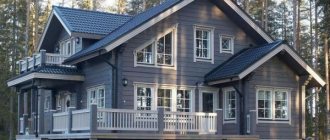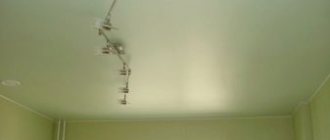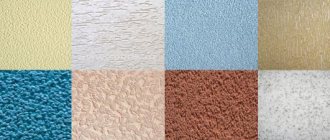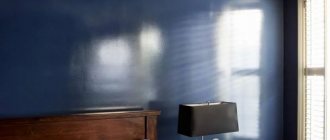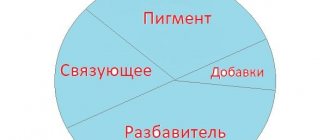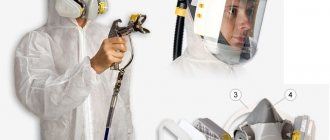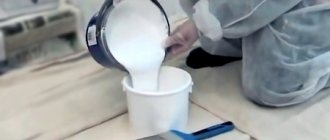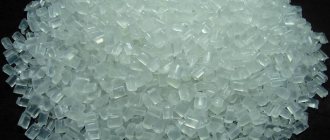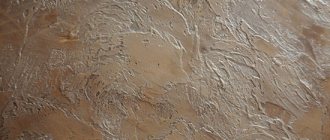What it is
Latex paint is a solution that consists of enamel made on a water-dispersed base. Its main component is natural latex, which provides a high level of protection from various types of exposure. This component by its nature is the juice of rubber plants.
If you use this element to make paints, then the cost of such material will be too high. To make it more accessible, it was decided to use synthetic polymers, which have an affordable price.
Despite the fact that latex paints are characterized by a liquid state that contains water, this does not allow the polymer particles to dissolve and stick together. After applying this solution to the surface, the liquid simply evaporates for some time. As for the polymer particles, they gradually begin to approach each other, and eventually stick together. After the water has completely evaporated, the surface dries and is covered with a continuous film, the adhesion to the surface of which is quite strong.
What are latex-based paints?
To obtain this type of material, natural or synthetic substances can be used. Natural elements are difficult to obtain in the required quantities, and are more often replaced by latex polymers. This replacement does not degrade the properties of the product, and may even improve some aspects of the product. Latex paint, what it is, will be easier to understand if you study the included components. The components of latex-based paint are the following:
- Polymers, they can be used in different ways, serve as binding elements;
- Thinner, most often water-dispersed types are produced, but in some the composition is diluted with organic solvents;
- Dye necessary to obtain a certain shade;
- Filler, it is responsible for what kind of coating will be after drying - glossy or matte;
- Additive substances that provide additional technical characteristics to the coloring agent.
Features and Benefits
Latex paint is obtained from rubber plants; it is a natural option for obtaining a component for this type of paintwork material. It is, for obvious reasons, expensive, and lately artificial polymers have been used more often. It is based on a water component; polymer elements do not dissolve with water, but do not stick together. When the paint layer dries, the water base evaporates and the polymer substances stick together. The result is a reliable paint coating on the wall.
The difference between paints lies in the polymer elements that were used in production; they affect the properties of the coating.
Among the advantages of such funds, the following points can be highlighted:
- The coating is durable, it can be washed after drying, the use of detergents is allowed;
- Eco-friendly composition, harmless, therefore they are often used for interior decoration;
- Vapor-permeable property, helps create an optimal microclimate in the room;
- Moisture resistance, you can use them for painting rooms with high humidity;
- The cost of funds is low, which saves money;
- It has thermal insulation of space, does not replace special thermal insulation materials, but increases the overall level of heat in the room; other paints do not have this property;
- Aesthetic property, the surface will have a matte effect, which serves as a good interior solution;
- High level of adhesion to surfaces, suitable for many types of substrate, therefore it is considered a universal product.
Benefits of use
Like any building material that is used for home renovation, latex paints have a number of positive characteristics, thanks to which they are in demand among a wide range of consumers.
Let's highlight the main advantages of latex paints:
- Any surface can be finished with latex paint. The solution fits perfectly on the walls, regardless of the method of its application.
- After painting, the coating is of high quality and durable, unlike the results of other paints.
- High level of environmental friendliness. Since the mixture contains no harmful components, the use of such material is absolutely safe . Such paints can also be used for rooms with high design requirements.
- You can create your own individual shade yourself. This is justified by the fact that the paint itself is white, and different colors are used to change the color.
- Economical. Since only 0.1-0.5 liters of solution are required per 1 m², this consumption is quite small. This indicator may vary slightly, it all depends on the quality of the surface being processed.
- Democratic pricing policy. Unlike the cost of oil-based enamel, latex paints are cheaper.
- High level of vapor permeability. Thanks to this property, the formation of condensation under the coating is excluded.
- After painting, a durable and resistant coating is obtained.
- The drying period of the paint is relatively short.
- Simplicity and ease of care. In case of contamination, the surface can be cleaned with a damp cloth.
Flaws
Despite the large number of positive characteristics of latex paint, there are also negative aspects:
- Before you start painting, the surface needs to be leveled and all defects eliminated. This is necessary because this material is not able to hide even the slightest defects in the wall. Thus, the surfaces must be perfectly flat;
- Low temperatures and sudden changes can cause damage to the integrity of the coating. The presence of drafts and a decrease in the level of the thermometer leads to cracking of the painted layer. To return the original appearance of the surface, you need to redo all the work;
- Latex paints are water-based and harmless to everyone around them. This applies not only to people, but also to various bacteria. Thus, if the painted surface has not previously been treated with a special impregnation or primer, then there is a high probability of microorganisms, including those hazardous to health, developing on it.
Latex for walls and ceilings
For interior decoration, water-dispersion latex paints are mainly used. After all, they have a number of positive qualities: fire safety, non-toxicity, strong durable coating, easy to use.
Plus, this paint ideally combines quality, performance characteristics and an affordable price.
Due to the fact that it is applied to various surfaces, including primer, plaster and wood, it contains a special substance that greatly simplifies the application process and improves adhesion.
After complete drying, they can not only be washed, but also cleaned. The surface is breathable and elastic. This paint dries in 5-6 hours, provided that the room temperature is not lower than 12 degrees.
To obtain the required viscosity, the paint must be diluted with water in a ratio of 1 liter per 6-9 m2 per layer.
Here you will learn about leveling the ceiling with plaster (video) and other useful tips.
Find out how to soundproof walls here.
Varieties
Latex paint is a finishing material that is used as the final stage of surface finishing. The quality of the resulting coating directly depends on the size of the fractions that are used in the solution.
Taking this indicator as a basis, latex paints are divided into matte, semi-matte and glossy categories. When making a choice in favor of a specific type, it is necessary to take into account its individual characteristics, as well as the characteristics of the room where the painting work will be carried out.
The use of matte paint makes it possible to visually change the space, namely, reduce it, hide small irregularities in the wall . Also, the distinctive characteristics of this type include resistance to regular cleaning and difficulty in maintenance, since it gets dirty easily and is difficult to wash.
To visually enlarge a room, glossy paint comes to the rescue. It gets even less dirty than the previous type, but it tends to wear off when washed. To achieve a positive effect from painting walls with a glossy solution, you need to carefully prepare the surface, namely level it, eliminating all unevenness and flaws.
Semi-matte paint has average characteristics. It combines the properties described above.
Types and applications
Washable latex water-based paint comes in different varieties, as mentioned earlier, different fillers are used, they give different capabilities to the coating. In order to choose the right type for a particular situation, you need to understand the varieties available on the market. The following types of material are distinguished:
- Facade type, used when it is necessary to cover the walls of a building from the outside;
- For work inside a building;
- There are specialized products for flooring; they are more wear-resistant and can withstand heavy loads for a long time;
- Compositions suitable for waterproofing work on various structures;
- Universal types that can be used both for the facade and for indoor surfaces, for example, for the bathroom.
Products may differ in the effect they achieve as a result of coloring. There are matte, semi-matte, glossy options; this variety makes it possible to choose the right option for any design.
The paint and varnish material also differs in its constituent components; the difference lies in the characteristics of the coating. Popular options will be discussed below.
Rubber acrylate-latex paint
This type was invented not so long ago, but it has already gained popularity due to its particular strength and resistance to environmental factors. Experts choose it for treating the surface of facades, sidewalks, swimming pools, and other surfaces that are constantly exposed to negative conditions. The product is diluted to obtain the desired consistency with water; special quality properties were obtained through the correct ratio of elements in the composition. The following advantages of rubber acrylate-latex paint are highlighted:
- Resistance to low-temperature and high-temperature influences;
- Quick-drying property allows you to quickly complete repair work;
- Universal, can be used on any type of substrate;
- Elastic property that prevents cracking of the layer during operation;
- Can be applied easily, using brushes, rollers, or spray guns;
- Durability of the result.
Stages of work
Painting a surface with latex paints is a process that is almost no different from painting with other solutions.
The following stages of work are distinguished:
- The surface needs major cleaning. All remnants of the old coating must be removed, and if significant defects form, they will need to be eliminated.
Depending on the expected result, the paint can be applied in several layers. The time between approaches depends on the drying time of the treated surface.
In case of paint contamination, it can be removed using either a solvent or a soap solution in the shortest possible time.
Applying this solution to the surface is not a very complicated process; you can handle it yourself . To achieve a positive result, experts strongly recommend adhering to the established sequence.
A roller, a brush, or a spray bottle is perfect as an assistant for this type of work. There is no big difference depending on the type of tool used. The only compelling argument for choice is the ease of working with it. It should also be remembered that the entire surface should be painted in one approach. Otherwise, there may be unevenness along the border of areas that dry out.
Thus, latex paint is a universal finishing material, which is characterized by a wide range of uses, namely for coating walls, ceilings and other surfaces. This mixture will also cope well with the processing of concrete, plaster, brick, wallpaper, drywall, etc. Due to its individual characteristics, this solution is excellent for treating both new coatings and those that have been previously painted.
Features of surface preparation
It will be standard for all water-based compositions. It is necessary to clean the peeling plaster. A spatula is suitable for this. This also applies to plaster affected by fungus. There will be less dust if you wet the ceiling twice with a sprayer or roller. In this case, several hours should pass between wettings.
If the ceiling is affected by fungus or is located in a damp room, it must be treated with a primer with an antiseptic. Once dry, you can use any penetrating primer. It is better to apply it with a brush so that the composition penetrates into all the potholes.
Then you need to putty all existing defects. The best option is acrylic putty. A wide spatula is preferred as a tool. It will be easier for a person who does not have sufficient experience to achieve a perfectly flat surface.
Irregularities can be sanded using a special machine. But you can also use the manual method. Then the primer is applied again. After it dries, the surface will be completely ready for finishing.
Which latex paint for the facade to choose
This question needs to be asked before making a purchase. In this case, you need to choose the option for outdoor work. There are paints based on acrylic and styrene-butadiene latex. They are a water-dispersed emulsion of resin and fillers. Compositions based on acrylic latex are called acrylic.
Almost all building structures can be coated with latex mixtures, with the exception of metals due to their susceptibility to corrosion. Acrylic paints are considered more water-resistant. For surfaces made of different materials, additives are used to ensure compatibility between the coating and the substrate.
Technical characteristics of latex paints:
- service life more than 7 years;
- Drying time of the first layer is 1-4 hours, depending on the weather and humidity;
- final drying of the painted surface – 24 hours;
- water absorption W=0.03;
- density 1.3-1.42 kg/l;
- application temperature – from -20 to +30 0 C;
- permissible operation of the coating - from - 50 to +70 0 C;
- the coating can be matte, glossy, silky-glossy.
When choosing the color scheme of the facade, you need to take into account that in regions with a hot climate you need to use light colors. Such walls will not overheat and will keep the color fresh longer. For northern regions, bright, rich shades are more suitable.
On wood
For wooden surfaces, acrylic paint has good breathability; it does not clog the pores of the wood, allowing it to “breathe,” which increases the service life of the material. However, the acrylic composition does not destroy microorganisms, so special treatment is carried out first.
Latex emulsion coating preserves the grain of natural wood, which is especially noticeable when using white paint. By adding a certain color to the mixture, you can paint the house in different colors.
On concrete
Latex water-repellent paints are used for concrete facades. This coating protects walls from moisture, ultraviolet radiation, and does not crack as a result of temperature changes. In this case, compositions for mineral surfaces are used.
Brick by brick
For brick walls, latex mixtures are chosen, which form a film on the coating that hides such a nuisance as “efflorescence.” They adhere well to the brick surface, which makes them indelible. At the same time, they do not interact with salts and alkalis, leaving the surface uniform and neat.
What to look for when choosing latex paint?
Now, knowing what latex paints are, it’s worth deciding what you need to pay attention to when choosing a paint to decorate a particular area of a house or apartment.
- It must be said right away that latex paints intended for indoor use are not suitable for facade work, since they are unstable to external factors.
Therefore, the first thing you need to pay attention to when studying the packaging is what kind of work the paint is intended for, internal or external.
- Wear resistance of paint. Thus, compositions intended for coating ceiling surfaces have lower wear resistance, so they are not recommended for use on walls. As a rule, the manufacturer indicates on the packaging for which internal surfaces it is recommended to use this type of paint.
Latex paint intended for covering the ceiling. It is not advisable to use it for walls - the wear resistance of the coating is low.
- Degree of whiteness. This parameter is also indicated by the manufacturer on packages of white paint. So, for example, for the ceiling, it is worth purchasing super white paint, which is ideally white without a yellow tint. It is best to cover the ceiling with two layers, having previously calculated the amount of paint for a certain area.
- Glossy or matte paint. According to this parameter, the paint is chosen depending on what effect is desired to be obtained as a result. Glossy paints, after drying on the surface, give a characteristic shine that can somewhat hide small surface imperfections. Matte paint is usually applied to a perfectly smooth surface; it does not give shine, and therefore will show all the irregularities and scratches.
This property of the paint is also indicated on the packaging. In some cases, the manufacturer designates it as deep matte, velvety matte, silky matte or silky glossy. Since the matte type of paint is more popular, experts recommend choosing a silky-matte version.
The decorative qualities of silky-matte paints are much higher than those of simply matte paints. Such compositions give surfaces a more noble appearance, do not become so dirty and are much easier to clean. However, their cost is slightly higher than the price of paints that have a different surface effect.
- Covering power. This parameter is also worth paying attention to, as it will help save on paint consumption. This has already been discussed above.
- Paint consumption per square meter is a parameter closely related to hiding power. Also indicated by the manufacturer on the packaging.
- Moisture resistance of paint. If you plan to paint surfaces in the bathroom, then you need to choose compositions that indicate this particular quality of the solution. This paint is equipped with additives that make the coating hydrophobic and allow wet cleaning.
The price of latex paint depends on its qualities and manufacturer. For example, moisture-resistant and facade compositions have a higher cost. However, for reasons of economy, this is not a reason to purchase a conventional option for wet rooms or exterior decoration, since it will not last long.
Some experts recommend choosing imported paint or one that is produced in Russia under a license from a foreign company. These recommendations are explained by the fact that foreign manufacturers have more experience in the production of such products, they use proven, proven manufacturing technologies, and they are constantly working to improve the characteristics of the compositions. However, imported or licensed paint has a significantly higher price. And the original products of many Russian companies often compete almost equally with Western ones.
Review of latex-based paint manufacturers and their prices
Among the manufacturers of latex facade paints, the most popular in Russia are: Tikkurila, Ceresit, Sniezka, Caparol, Admiral, Oreol, Pigment.
The Finnish company Tikkurila produces the following compositions for finishing facades:
- Euro-facade for wood. A 9 liter bucket costs 3.5 thousand rubles.
- Kivisil for concrete, brick and plastered walls. The cost of 9 liters is 1.8-2.0 thousand rubles.
- Novasil for mineral surfaces, except lime plaster. Packaging 9 liters has a price from 1.8 to 5.7 thousand rubles.
Note! To obtain different colors, color is added to the paint in the form of a paste marked VT, MK, ZK. To ensure uniform color, the composition is thoroughly mixed.
Among Ceresit facade paints, the ST-54 brand is most often used. The cost of packaging 15 liters is 2.8-3.5 thousand rubles.
Acrylic facade mixtures from Sniezka, packaged in a 10-liter bucket, cost 2-2.5 thousand. They have a base white color, tinted by adding a coloring pigment.
It is gaining more and more consumers among Russians. Facade acrylic paint Lakra is suitable for walls made of concrete, brick, plaster. Has a consumption of 6-7 kg/m2. The cost of a 3 kg can is about 400-450 rubles.
The latex-based composition for painting facades Oreol is intended for coating structures made of mineral building materials and wood. The price of the product in 3 kg packaging costs 380-400 rubles.
Application technology: instructions and video
The process of painting a facade begins with its preparation. To do this, carry out the following work:
- Clean the wall from the old finishing layer, remove dust, and wash it.
- Apply a layer of primer.
- Level the surface with putty or plaster.
- Apply the required number of layers of coloring composition.
Let's consider all stages of work in more detail.
Cleaning
Clean the surface of old finishes, peeling plaster, and crumbling cement from brick joints. Remove old paint from wooden walls with sandpaper or a sander until the surface is completely smooth.
The facades are washed with water to remove dust, mineral chips and dirt. It is enough to rinse the walls of new houses well to remove any remaining cement mortar and dust. To do this, use hoses that supply water under pressure.
Impregnation
Impregnation before applying latex coating is carried out mainly for wooden facades. Basically, such compositions do not protect the tree from bacterial attack. The following types of impregnations are used:
- Antiseptic. They prevent the development of mold fungi, which are activated in a humid environment.
- Insecticidal. It repels wood-boring beetles and makes the wood inedible for them.
Padding
Priming a surface for painting has several purposes:
- protection of the facade from the negative effects of the environment;
- improving the adhesion of paint to the wall;
- filling small cracks and surface defects, which reduces paint consumption.
Primers come in deep penetration and filled. The former penetrate the pores of the material and help improve its adhesion to the paint. The second is to eliminate minor defects on the surface of the walls.
The primer forms a film, reducing the moisture absorption of the wall, reducing its porosity, which saves paint consumption. Apply using a brush, roller, spray gun or spray gun.
Important! Water-based primers are used for acrylic and latex paints. Almost every manufacturer of facade paints also produces corresponding primer compositions.
Coloring
The dyeing process includes the following operations:
- Begin to paint hard-to-reach and narrow areas using a brush and roller.
- Large wall surfaces are painted using a spray gun or spray gun.
- Wait for the layer to dry, which ranges from 30 minutes to 2 hours.
- After the first layer has dried, repainting is done. Usually, two layers are enough. The coating is completely polymerized within 24 hours.
Latex washable
This type of paint is intended for interior and exterior use.
Used for painting ceilings and walls in rooms with high levels of humidity and intense load.
It can also be used for painting glass wallpaper and other surfaces with a non-woven base.
Before starting work, it is necessary to carefully prepare the surface and pre-prime it. If there are cracks and potholes, these should also be repaired.
In order to achieve the required paint viscosity, it can be diluted with water. Apply with a roller or brush in one or two layers.
You can read about the benefits of garage flooring here.
Is it possible to glue new wallpaper onto old ones? Of course, the main thing is to know how.
All information about installing sliding doors is here.
Reviews
Latex compounds have their advantages and disadvantages. This list is based not only on the approval of the manufacturers, but also takes into account the opinion of the builders who used paint when finishing the facades.
- obtaining a matte or glossy surface;
- durable and reliable coating;
- moisture resistance;
- breathability;
- quick drying;
- no unpleasant odor when applying paint;
- does not emit toxic fumes;
- using coloring pigments, the facade can be given a different color;
- long service life.
The disadvantages include the following characteristics:
- requires careful leveling of the surface, otherwise all flaws will be noticeable;
- It is necessary to use a primer;
- It is necessary to pre-treat the walls against fungi and microorganisms, which is mandatory for wooden walls.
The domestic latex composition “Lakra” received a lot of positive feedback. Here's one of them:
We used Lakra to paint the exterior wooden walls of a country house. We were surprised by the large selection of shades and low prices. We saved money and made no mistake. It's been three years and the paint is still like new. True, they chose dim shades so as not to fade. It does not peel or crumble anywhere.
Caparol façade paints receive positive reviews. Their quality is undeniable, but not all consumers can afford such a composition.
Alpina facade paint has recently become popular. It belongs to elite materials, has real German quality, but a rather high price. It also produces primers and mixtures for interior finishing work. When purchasing paint to decorate the facade of your own home, you should study the offers of various manufacturers, evaluate their quality and price. It is better to opt for products from campaigns that have a long experience and positive customer reviews. You need to decide on the characteristics of the product and choose what you need.
The name of latex coatings is justified. The material is based on latex. In nature it is the juice of rubber. Synthetic latex is used to produce paint. It is much cheaper than natural one. It is an aqueous dispersion of synthetic rubber. Its formation is the result of emulsion polymerization. Hence the conclusion that latex is not a combination of chemical elements, but a state of matter.
It is the basis for the production of latex CM. A water-soluble dispersion of polymers (styrene butadiene, polyvinyl acetate, acrylate, siloxane) is latex paint. It is classified as one of the types of water-based compositions.
The mechanism of action of latex-based dye is divided into 2 stages:
- As long as the paint is liquid: the particles of the binder stick together, but do not dissolve with water.
- The surface is colored by the CM: evaporation begins, the attraction of particles increases. A film is formed that has good adhesion to the base, protecting it.
Depending on the manufacturer, the technical characteristics of latex-based CM differ. Average data considered:
| Specifications | Indicators |
| Specific gravity of 1 liter KM or density, kg/dm 3 | 1,3-1,7 |
| The ability of the pigment, when applied uniformly, to cover the color of the base or hiding power according to DIN EN13300 standard | 2nd grade |
| Wash resistance according to DIN EN13300 | Class 1-3, depends on the composition and area of use. |
| Size of large solids in a mixture of pigment and film-forming substance or grinding level of components, mKm | 20-80 |
| Permissible temperature during application | From +5 o C to +30 o C |
| pH level | 7,5-8,5 |
| Drying speed, hour | 3-5 |
| Consumption of latex-based CM per 1 m2, ml/m2 | 90-350 |
Characteristics and Features
The paint is made on a latex base with the addition of acrylic. The mixture is available exclusively in white. But to make it multi-colored, you need to add tinting components. It can be applied to concrete and brick walls, as well as wallpaper or plaster.
There are compositions intended for application in rooms with high humidity.
Latex paint is in demand due to its positive characteristics:
- No pungent odor.
- High environmental performance.
- Passes air vapor through itself.
- High thermal insulation properties.
- Not afraid of temperature changes.
- Not afraid of moisture.
- Durable, wear-resistant, does not fade.
- Dries instantly.
There are some features of latex paints:
- The growth of bacteria and fungi is possible on the finishing surface. Therefore, I recommend using a primer before applying it.
- As a rule, mixing with color does not allow you to get too saturated shades.
To obtain the desired shade you need to use a color
Latex-based paint is an independent finishing material that does not require additional processing or coloring, as well as the application of pigment and other components.
On different surfaces it may visually differ in degree of smoothness. This happens depending on the size of the fraction. For example:
- a matte surface is created by adding a large fraction;
- glossy - as a result of mixing with a fine fraction.
Paint is divided into three categories:
| Photo | Description |
| Variety 1. Matte Difficult to wash, but capable of eliminating visible defects. Can visually reduce space. | |
| Variety 2. Semi-matte Mixed type. Reacts well to washing, does not wear out, does not fade. Often used to paint ceilings. | |
| Variety 3. Glossy Visually increases the space. The surface wears off during washing. The wall on which the composition is applied must be smooth and straight. |
Application area
Latex paint is a universal paint mixture. Ideal composition for walls of any type. The material can be used for both external and internal surface finishing.
The scope of latex-based paint depends entirely on the components of which it consists. For example, an acrylic silicone compound that contains a special antifungal agent is well suited for working with external walls.
Finishing with latex-based paints is easy to clean and reflects light, making the room feel more spacious.
For interior work, you can choose the following types of wall material:
| Photo | Description |
| Option 1. Butadiene-styrene composition The basis of the material is PVA glue. Plus components that contribute to the wear resistance and moisture resistance of the paint. It fades easily, but is great for interior decoration of the kitchen, hallway, pantry and dressing room. | |
| Option 2. Polyvinyl acetate paint This is a type of water-based mixture that is completely odorless. The basis of the material is PVA glue. The price is low. It has an interesting feature: before it dries completely, the paint can be easily washed off with water. But dried paint gives a chalky effect that can ruin clothes and furniture. It is not recommended to use in the kitchen and bathroom, as the surface is washed off with water. | |
| Option 3. Acrylic composition Acrylic paint is a high-quality material for interior wall painting. Characterized by high resistance to dirt, dust and moisture. Acrylic paints protect the wall surface from corrosion. The finish can withstand up to five thousand washes, as the surface is elastic and moisture resistant. |
If you are faced with the question of which paint to choose: acrylic or latex, you should think about the characteristics of the room in which you are going to use it. For example, cracks that can be found after applying latex paint will not appear on a painted surface with acrylic compounds.
The composition is applied with brushes or foam rollers: light and even movements
The main differences between latex paint and acrylic paint:
- Latex paints are more durable.
- Acrylic compositions are cheaper, but require careful surface preparation.
Preparing the surface for paint application
So, latex paint requires high-quality preparation of the wall surface before starting the work process:
- The walls are cleaned of dust and various contaminants. It is good to use ordinary water and a sponge at this stage.
- Old plaster and other wall materials are removed. A construction spatula will be an excellent assistant at this stage.
- If possible, the wall surface is treated with acrylic impregnation. This will prevent possible cracks from appearing on the painted surface.
- Next, it is necessary to apply a penetrating primer, for example, the facade part due to this receives additional strength and thermal insulation.
- It is better to eliminate all unevenness and other defects using putty.
Working with any paints must be accompanied by personal safety measures: use gloves and respirators
Wall painting technology
The technology of painting walls with latex paint occurs in only five stages. It is required to approach each stage responsibly. Only in this way can you obtain a high-quality painted wall surface:
| Photo | Instructions |
| The first stage is preparing the paint The paint is diluted using cold water in accordance with the attached instructions. Some experts advise using purified and even distilled water, but you can also mix the paint with regular tap water. | |
| The second stage is applying the first layer The first layer is applied after thorough dilution with water. As a rule, the consumption of one liter of water is 7–10 m². Much depends on the material of the wall. For example, wood will need more paint and, accordingly, more water. For 1m2 you will need about a quarter of a can. | |
| The third stage - choosing a tool Foam rollers, molar brushes, and even spray bottles work well for latex-type paint. When using a roller, you will need a special container for rolling out the paint, but you can also use regular cardboard. | |
| The fourth stage is the arrangement of layers I note that the paint has an interesting feature: the layers should be perpendicular to each other. Matte paint looks especially attractive in this design. | |
| Fifth stage - coating It is necessary to cover the walls with uniform movements. This is the only way to get smooth and beautiful walls. |
Modern capabilities allow you to adjust the degree of gloss in different rooms and on facades
Pros and cons of using latex paints
- The dye is easy to work with; it covers the surface evenly without difficulty; any painting tool can be used.
- Long service life of the covering layer. The leader among water-based paints.
- The material is harmless to health. Contains no toxic chemical solvents. Paint for interior work, approved for cladding in institutions and children's rooms.
- The ease of working with CM is explained by the absence of a pungent odor. When the coating in the room is dry, you can immediately settle into it.
- The composition is produced in the base color - white. To obtain the desired shade for the implementation of the design, pigment is introduced.
- A low average paint consumption rate is declared - 0.4 l/m 2. But it depends on the ability of the surface to absorb moisture, on its quality.
- Latex composition is affordable for the average buyer. It combines quality with price.
- The coating dries quickly. After 6 hours, a second coating is performed.
- The vapor permeability of the coating allows the base of any material to breathe, which maintains the microclimate in the house. There will be no dampness, condensation, or prerequisites for mold.
- Latex paint is easy to apply and the coating is washable.
- Since the material is moisture and weather resistant, it is used for painting outdoors.
Advice: manufacturers prescribe on the container the technology for using latex paintwork materials, which makes it easier for beginners in the painting business to work with it.
Knowing the negative aspects of the dye allows you to avoid mistakes when working with it:
- Latex water-based paint is applied to a carefully prepared base. Otherwise, its defects will be noticeable. It is cleaned, leveled, and adherence to the CM is ensured.
- When working with the composition, drafts must be avoided. The coating is deformed due to temperature changes. Paintwork does not tolerate low temperatures.
- The composition does not contain antiseptics, so before applying it, the base is treated with special agents that fight microorganisms.
Advice: preparation of the base does not take place without priming it. It is recommended to treat with a primer of an identical brand of latex dye. This is a guarantee of the quality of the covering layer.
Advantages and disadvantages
The advantages of the material include:
- Strength.
- High vapor permeability.
- Elasticity.
- Low consumption.
- Quick drying (in some cases this property may be a disadvantage).
- No smell.
- It dissolves in water, which makes it easy to get rid of drips or stains, and also to keep the instrument clean.
There are also disadvantages:
- Difficulties with painting metal structures.
- The compositions are produced as a base for coloring, i.e. Before application, the addition of pigment is required to give the desired color.
- They darken somewhat when dry, which requires some experience when mixing with dyes (pigments).
- Limited shelf life - 6 months; when purchasing, you must pay attention to the release date.
Classification by binder polymers
The group of water-dispersed paints and varnishes includes latex paints. This is their common name. So what is latex paint or its varieties? When a certain binding polymer is introduced into the composition, the result is a new water-based subtype of CM.
- Water-dispersed dye based on PVA or polyvinyl acetate CM without solvents. High tenacity coating with base, no toxic odor. Undried paint can be quickly washed off if necessary. The view is affordable.
Criteria for choosing varnish material
Latex dye is selected based on its 3 main qualities:
- moisture resistance;
- wear resistance;
- long service life.
The degree of gloss coverage of the surface is taken into account. This indicator is important because gloss is more wear-resistant. But such a coating does not hide base defects. All the irregularities and shortcomings are visible. It is recommended to apply a semi-gloss finish. The matte finish visually masks unevenness, is easy to apply, and washes off dirt well, but its accumulation quickly becomes noticeable. A room painted with matte paint visually becomes smaller and darker.
You need to find out information from the seller about the number of dye abrasion cycles (wet and dry). The wet abrasion indicator is written by the manufacturer on the container.
- for a dry room, a CM with one thousand abrasion cycles is purchased for the ceiling;
- for the walls of a dry room - 1-2 thousand abrasion cycles;
- for a room with humidity - up to 3 thousand abrasion cycles;
- for facades - from 10 thousand abrasion cycles.
The level of abrasion of the coating layer is expressed by the paint class:
- first class – average stability;
- second class - the coating can be wet cleaned without fear;
- third class - the degree of abrasion is low, but the layer is moisture resistant;
- fourth class - used in dry rooms;
- fifth class – resistance to dry and wet abrasion at a low level.
The following brands are in demand on the Russian market:
- Dulux, UK. Ceiling lining – Creations Moonlight; for indoor work, a matte coating is formed - KM Latex Matt; vapor-permeable CM Brilliant White;
- MANDERS, UK . Compositions are available in an assortment of colors. Wood and metal are painted – Intelligent Exterior Eggshell; brick, stone, plaster – Masonry Paint;
- Tikkurilla, Finland. One liter covers an area of 8 m2. For children, Euro 2 is recommended; with increased wear resistance for corridors and kitchens - “Euro 12”; for the external cladding of the house - “Euro Facade Aqua”; with antiseptic – “Luya”; for the ceiling - “Euro Sealing”;
- Caparol, Germany. For indoor work – Samtex 20 ELF; matte coating for ceilings and walls – Aqua-inn N°1, for surfaces with maximum load – SeidenLatex;
- Brands from Poland: Ceresit, Snezka, KABE .
Paint selection
To choose the ideal latex paint for ceiling decoration, you need to decide not only on its shade. An important parameter is the degree of gloss, which is divided into 6 categories. The lower the gloss number, the more matte the surface will be after drying.
A composition that provides an almost mirror-like finish is extremely rarely chosen, especially for walls. The most popular is considered to be a moderately matte paint.
It is also necessary to take into account parameters such as moisture and wear resistance. You can judge them using the abrasion cycle indicator, which is indicated on each package. The higher the number, the more durable the finish will be. Sometimes this characteristic is indicated in classes, the highest quality of which is the first class.
What is used to dilute the dye?
Having opened a jar of CM, it is checked for consistency. Most often it is diluted before use. Water is used as a solvent since it is a water-based dye. The resulting paint of the required viscosity remains harmless, has no odor or toxic substances, and dries quickly. The CM is thoroughly mixed and after that water is introduced.
- Before applying the first coating, 15-20% liquid is added to the composition.
- For each subsequent coating, 10% water is required.
Important: wallpaper is painted with ready-to-use latex paint.
What is latex paint: how to work with it
One of the most commonly used materials when repairing ceilings is latex paint. It makes it possible to finish the ceiling efficiently and in the shortest possible time. Moreover, it is so easy to apply that even a person without any experience can handle the job.
Latex paint is an emulsion consisting of droplets of pigment, water and binders. Once applied to the surface, the water will evaporate and the binder and pigment will stick together into a single unit. As a result, a thin film is formed on the surface. Both mineral compounds and synthetic resins can be used as a binder. This is a kind of washable paint that makes cleaning much easier.
Latex paint for interior work, washable
